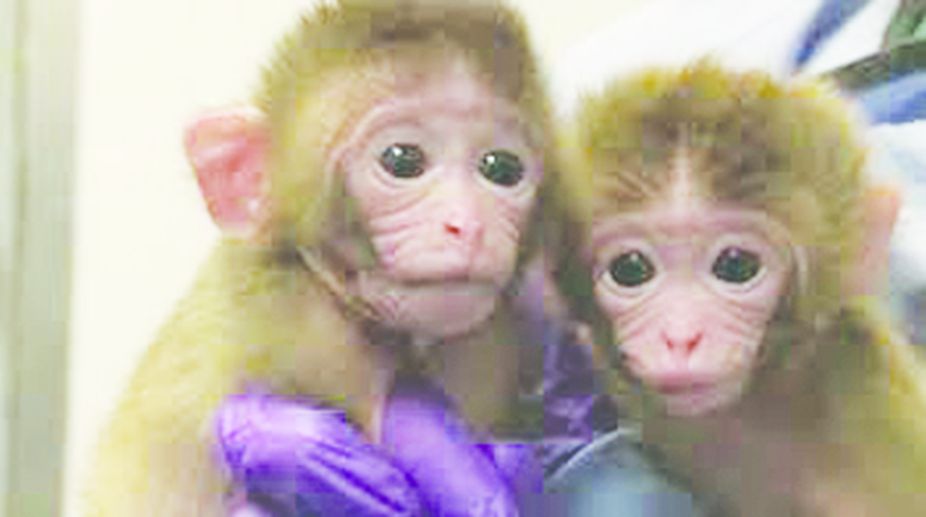In a major scientific breakthrough, Chinese scientists have in January cloned two female macaques, name Zhong Zhong, and Hua Hua, the genetically identical twin monkeys. The scientists used the same technique that had once created the famous Dolly sheep. The watershed achievement was accomplished by the Chinese Academy of Sciences and published in the reputed science journal, Cell, by a team led by Dr Zhen Liu. Hopefully, the milestone will eventually pave the way of cloning human beings, maybe by using the same technique. The exactly identical long-tailed macaques, resembling each other genetically, represents the high watermark of the cloning technology and advancement in the field of scientific and biomedical research.
The breakthrough has been greeted with mixed reactions, both within the scientific fraternity and charity organisations. Some scientists are skeptical about the efficacy of the cloning technology, its pragmatic application in biomedical research where such factors as genetic variability can complicate the experimental process and ultimately lead to a dangerously wrong direction.
This could jeopardize human existence. However, others are optimistic and they believe that the technique would be tremendously useful in research on medical genetics, prognosis, and the study of treatment that affects the genetic makeup of human beings and animals. This is indeed a historic achievement with profound implications. The geneticist would be capable of experimenting and studying the identical and cloned monkeys for specific genetic changes.
According to Chinese scientist Qiang Sun, “this will generate real models not just for genetically based brain diseases, but also cancer, immune or metabolic disorders and eventually would allow us to test the efficacy of the drugs for these conditions before clinical use”.
In point of fact, the monkeys, Zhong Zhong and Hua Hua, are not the first cloned primates. But they are the first to be produced by using the single cell nuclear transfer (SCNT) technique that was adopted for creating the Dolly sheep. Theoretically, therefore, it would be possible to clone human beings since the primates (monkeys, apes) resemble us by way of evolution and share much in common. At the same time the ethical, cultural and regulatory objections should also be taken into consideration before proceeding with biomedical research in this sphere.
Decades ago, scientists working on genetic engineering in South Korea had produced a cloned dog, created from the skin cells of an Afghan hound. The process of cloning domestic animals is as intricate as it is dangerous. The skin cells are incorporated into the egg cell to form a number of cloned embryos. Then only one cloned embryo is embraced by a golden Labrador, the surrogate mother of the cloned puppy. Professor Woo-Suk Hwang of Seoul National University and his colleagues had announced these important achievements and named the puppy Snappy in 2005.
Scientists have already succeeded in cloning animals like the sheep Dolly, pigs, mice, goats and cows. In cloning primates like monkeys, apes and human beings, the scientists might use the same comprehensive technique as used for other animals. Though the research programme is ambitious, the technique raises many ethical and philosophical questions. There is also a dispute among scientists regarding the efficacy of the research. Some scientists have warned that the cloning process may produce genetically abnormal or defective offspring. Some have argued that the research would lead the culture of science in a wrong direction.
Cloning is a departure from the process of fertilization which occurs sexually by the union of a sperm and an ovum, usually inside the mother’s womb. The geneticists, on the other hand, produce the offspring from an individual body or tissue cells without fertilization. This process is known as cloning and it may be described as asexual reproduction.
A clonal offspring has one parent; a baby can be produced even with the help of the mother’s body (tissue) cell and there is virtually no need for a male counterpart. The cell taken from a female body and allowed to clone would develop a baby with the mirror image of a single parent. Hundreds of similar offspring with the sex of a single parent may be produced. The genetic code directs the production of proteins in the body. However, when a change in the genetic code takes place, it is called mutation and can lead to genetic disorder.
Scientists have been able to change the genetic code in order to yield the desired outcome. Testing the unborn can be done and it helps the pregnant mother to ascertain whether any genetic disorder persists in the body of the unborn baby so that the parents could consider abortion which in itself is a controversial issue. Complete cure of a genetic disorder is difficult. Scientists have introduced a new and correct genetic material into the cell.
Cloning is an asexual process. An African frog was developed by adopting the cloning method by Professor J B Gordon of Oxford University. He extracted an unfertilized ovum from the body of the frog, destroyed its nucleus with ultraviolet light. Then he collected a body cell from the frog, extracted its nucleus out of the cell with a microscope and implanted this nucleus in the ovum’s cell. The cell division started immediately and finally a mature frog developed.
The most striking feature of a clonal offspring is that it is always a replica of the parent of the body cell donor and does not inherit any genetic characteristics from the ovum cell. It is surprising that a human female can donate both the ovum cell and the body cell for the purpose of cloning. In that case the baby will be identical to the female parent. There will be no need for a male counterpart in the reproduction process. This may perhaps be perceived as a tragedy for the male sex potential.
However, the male would be able to donate the body cell for cloning. In that case, the baby would be identical to the male single parent. By taking the body cell of Donald Trump or Narendra Modi, geneticists would be able to reproduce thousands of replicas confidently. Or if permitted, they could create many replicas of scientist Stephen Hawking, author of The Grand Design or singer Lata Mangeskar.
Geneticists are confident about producing a cloned human baby any time. They believe that about 70 million infertile men across the world would be able to have children by this process. According to many geneticists, it is also a religious culture, an article of faith aimed at perpetuating life and definitely not the belligerent attempt against the creation of the creator. However the anti-cloning lobby has argued that the entire process has not yet been mastered. Even experiments with animals so far have produced abnormal babies. About 18 per cent of the cloned mice died, as did 38 per cent goats before maturity. Human cloning can, therefore, turn out to be disastrous.
The ethical or philosophical questions need to be addressed. Who will decide what human traits are to be preserved or bred? If the natural genetic variability is bred out of the human population, what would be its consequences? What type of society will geneticists bring about? Who will be empowered to decide what is good or bad genetic make-up? What would be the relationship of a clone with society?
There are inherent dangers in the manipulation of the human genetic code. But cloning a human baby by applying the genetic engineering technique is a work of art. An artist paints a picture with colours and brush. The geneticists’ ingredients are different. They use enzymes, genes, nucleotide bases and some chemical components. Hopefully human cloning would be a manifestation of remarkable aesthetic beauty where philosophy, science and ethics are intertwined.
The march of human progress, scientific advancement and civilization reminds one of Robert Browning’s words: ‘Grow old along with me, the best is yet to be’.
The writer, a former Reader in Chemistry, Presidency College, Kolkata, was associated with UGC and UNICEF











